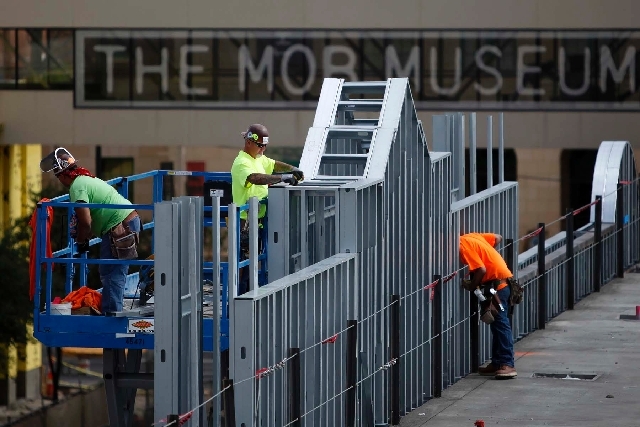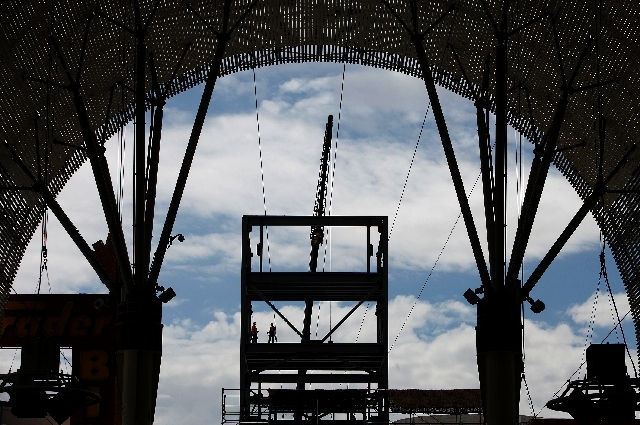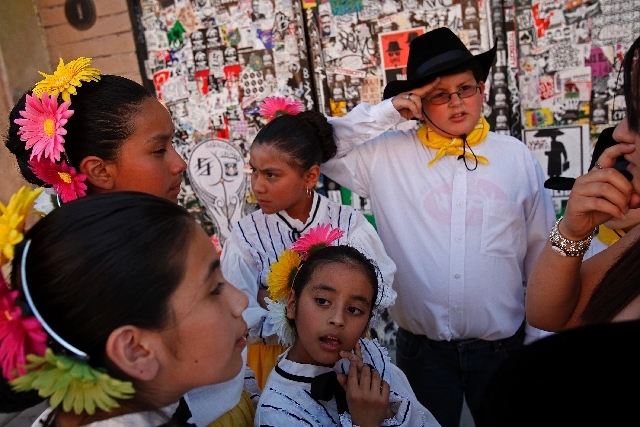Las Vegas councilman concerned about costs of downtown projects
In the depths of the Great Recession, downtown Las Vegas defied economic gravity with a building boom that included bars, restaurants, a new City Hall and the Mob Museum.
Now bills are coming due, prompting concerns that city taxpayers might be stuck with more of the tab than they bargained for.
And with the local economy wheezing — as opposed to roaring — back to life, it could be awhile before land values increase to the point where property taxes downtown can carry the burden alone.
Some say city officials are so busy heaping praise on efforts to revitalize the formerly forlorn downtown core that they’re unwilling or unable to acknowledge potential problems.
“Our income will no longer pay our mortgage,” Councilman Bob Beers said. “I don’t hear that discussed or acknowledged, and to me going forward it is a pretty significant problem we need to address.”
Even ardent downtown boosters acknowledge the redevelopment agency took a huge hit during the recession as the value of taxes collected dropped from about $28.3 million to $13.2 million from 2010 to 2012.
But they are adamant the recovery is underway and say new projects coming onto the tax rolls, such as the Zappos corporate headquarters in the old city hall building and the Downtown Grand resort on the site of the former Lady Luck, will help balance the books.
“That is all going to be new taxable values that will hit the tax rolls,” said Scott Adams, the city’s chief urban redevelopment officer. “We’ll climb out and recover that value drop. At some point we will cross back over and the agency will end up supporting itself again.”
Others argue that downtown redevelopment has a citywide benefit and aren’t overly concerned tax money would flow from outside the city core into the downtown area.
“It is a matter of community pride for the entire city,” said Councilman Bob Coffin, whose ward includes much of downtown. “Citizens all over the community take pride over what is happening in the redevelopment area.”
REDEVELOPMENT’S START
Launched in 1986 with the blessing of the Nevada Legislature, the redevelopment agency was meant to focus the power of local government on the improvement of downtown Las Vegas.
The idea behind redevelopment is to give local government the authority to focus spending in a specific area to combat blight without raising tax rates or siphoning money from existing general fund programs.
It does that by targeting developer incentives, project subsidies and other improvements in a specific redevelopment zone. The spending, in theory, drives development which increases property values, resulting in more property tax revenue.
A small slice of the revenue from the increase, or increment, is then reinvested into more redevelopment projects.
The agency, with a board made up of City Council members, mostly flew under the radar and when it did enter the public consciousness it was often due to controversy.
One of the biggest was in the early 1990s when the city, under the mission of redevelopment, used eminent domain to take property from the Pappas family to build a parking garage for the Fremont Street Experience. It started an ugly legal dispute that lasted more than a decade and ended with a $4.5 million settlement for the family.
Another high-profile redevelopment headache has been the saga of the Neonopolis shopping center at Las Vegas Boulevard and Fremont Street. The city-subsidized venture has cycled through countless tenants and so far failed to find its economic footing, although it does appear to be on the upswing lately.
The redevelopment agency also boasts high-profile success stories such as leading the conversion of a former brownfield west of Main Street into a burgeoning area that’s home to The Smith Center for the Performing Arts, World Market Center, Las Vegas Premium Outlet Center, Lou Ruvo Center for Brain Health and the Molasky office building.
But at the same time long-term efforts to revive downtown were bearing fruit, the broader economy was unraveling and redevelopment revenue from property taxes took a dive.
Now the agency is seeking a bill from the Legislature that would tack another 15 years onto its original life span, which was supposed to end in 2031. City Chief Financial Officer Mark Vincent says the extension would allow the agency to refinance long-term debt to reduce payments as much as $3 million annually, although he acknowledges refinancing over a longer period would increase overall borrowing costs.
COUNCILMAN BEERS’ CONCERNS
Concerns by Beers, an accountant by trade, trace to his own analysis of financial reports from the downtown redevelopment agency.
He says financial statements show the tax revenue, after state-mandated set-asides, no longer covers the cost of debt service, let alone operations.
And that doesn’t include the additional cost of payments for the $146 million City Hall that opened in 2012. City promotional material suggested new development around the structure at 495 S. Main St. would offset the cost of payments. So far that hasn’t happened.
Reserves and revenue shifts have papered over the problem for now but a sustainable solution would likely require more property tax revenue from the downtown area or cuts to other spending to keep up with redevelopment costs.
Beers says he views the city general fund and redevelopment agency as a single entity and is troubled by the continuing trend of public spending outpacing revenue with the difference coming from reserves, which will eventually run dry.
“I, personally, would rather see the city balance its budget sooner rather than later,” Beers said. “To me the council and city manager need to have that broader, more sweeping discussion on what we are going to do.”
Beers’ analysis showed that after state-mandated set-asides for affordable housing and education, property tax revenue in the redevelopment area fell from $23.2 million to $10.8 million between 2010 and 2012.
During that same period debt service fell from $14.3 million to $13.5 million. Staff and redevelopment incentives fell from $19.7 million to $6.8 million, Beers’ analysis shows.
City officials made a number of financial moves to borrow money and shift one-time revenue from outside sources into the redevelopment agency.
Among the biggest was an approximate $15 million loan from the sewer enterprise fund, most of which went to help build the Museum of Organized Crime and Law Enforcement, also known as the Mob Museum.
“It is cheap money,” Vincent said of the reason for taking a loan from the sewer fund. “I don’t have to go out in the market.”
Other money came from a $3 million refund from a contingency fund that went unused during construction of The Smith Center and reserves that fell from $30.7 million to $19.2 million, Vincent said.
Outside funding for redevelopment didn’t end in 2012.
The 2013 budget included another $1 million for programs aimed at giving small businesses cash incentives to open downtown. Another $1 million was used to fund the creation of a second redevelopment area just south and west of the one downtown.
In the 2014 budget the city is anticipating about $9.3 million to help pay off the new City Hall, a project the city funded through a lease-purchase agreement with developer Forest City. Payments are set to increase to $13.4 million by 2017.
When former Mayor Oscar Goodman was promoting the idea of a new City Hall, city marketing material suggested payments would be covered by revenue gains from development spurred by the project.
A fact sheet posted on the city website says “future redevelopment tax revenues from all the projects that the new City Hall sparks can be used to make payments.”
So far that development hasn’t happened. Lots to the south that were envisioned as privately built offices remain vacant. A retail space in the City Hall parking garage is empty.
The spending grows in significance given the city is struggling to pay firefighters and city employees, and asked the Legislature to support a countywide sales tax increase to help fund police throughout Clark County.
Scott Johnson, president of International Association of Firefighters Local 1285 in Las Vegas, said that in tough times the city should pare back such spending.
“Obviously in difficult economic times it is something that has to be put on hold so the city maintains the ability to provide essential services,” Johnson said.
Geoffrey Lawrence, an analyst at the conservative Nevada Policy Research Institute, said tough financial times for the Las Vegas Redevelopment Agency show that committing public money to private projects can be risky for taxpayers. “I think that is money that could legitimately be used somewhere else,” Lawrence said. “This isn’t why most people think they are paying taxes.”
REDEVELOPMENT POPULAR
Despite concerns in some corners about the costs of redevelopment seeping into the city’s general fund budget, redevelopment programs remain popular for a couple of reasons.
For starters, many are convinced property values are set to rebound, which would swing the redevelopment agency back to black.
Also, programs to give cash to businesses in the redevelopment area are routinely praised by businesses receiving the money and government officials handing it out.
During a recent redevelopment meeting, restaurateur Jenna Morton credited a facade improvement grant worth up to $45,000 for prompting the decision to open the trendy Mexican restaurant La Comida on Sixth Street, about a half block south of Fremont Street.
Private money from investors paid for a reported $2 million in renovations to make the restaurant, and the more than 50 jobs it created, possible. It also livened up a formerly desolate stretch of Sixth Street.
“Those were key with our making a choice to purchase downtown,” Morton said. “I think those programs are essential to the development of downtown.”
Even Beers’ business partner, restaurateur and politically active conservative George Harris, gave glowing testimony about redevelopment during discussion of about $30,000 in grants for Mingo, Kitchen and Lounge, a restaurant he recently opened on First Street.
Beers abstained from the vote because he is a partner in Harris’ other restaurant, Mundo, in the World Market Center.
“The redevelopment agency has just been a pleasure,” Harris said. “They have gone out of their way to do everything to help us.”
For Beers’ part, he said he mainly wants the City Council and senior staff to acknowledge the disparity between revenue and spending.
It’s an issue that’s related to his push for an ordinance that would exempt buildings constructed before 2009 from certain energy efficiency code requirements, which he said drives up the cost of renovating downtown buildings that forces the city to spend money on incentives to offset the cost.
He’s frustrated that so far his warnings about the redevelopment budget have yet to gain traction. The proposed 2014 redevelopment budget shows $13.1 million in property tax revenue and about $12.8 million in debt service.
That, however, overlooks the state-mandated set-asides of 18 percent, Beers said.
“The revenue from the RDA has collapsed and the first step in dealing with that is recognizing we have an issue,” Beers said. “But as you see in that budget we don’t even have the set-aside accounted for, which doesn’t exactly make it transparent.”
Contact reporter Benjamin Spillman at
bspillman@reviewjournal.com or 702-383-0285 .



















